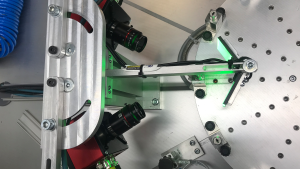Crack detection in the pressing plant
Solutions for medium-sized businesses
Is it possible to detect a crack in the forming process before it occurs? We say yes!
This is because even before a crack occurs, a necking slowly creeps into the forming process. As soon as certain elongation limits are exceeded or material properties are undercut, the material can become unstable in specific areas and constrict, leading to a loss of cross-section. This narrow section is called the “neck” and could be a precursor to fractures or cracks. But the constriction itself can also cause severe stressful situations later on.
Pressing plants must therefore react quickly to initial signals in order to adapt the parameters of the forming process to the current material properties. And it is precisely here that the evoVIU is the right companion to support engineers and workers in the production environment with its ability to identify faulty components at an early stage and pass the message on to the employees or automation system. This saves an enormous amount of time and material and offers additional safety throughout the batch.
Do you have a region that is constantly affected by tears and constrictions? Then place the camera directly in the closer within your desired drawing level. Don’t worry, the evoVIU was developed precisely for this environment. Whether on the feeder tooling or in the storage area.
With our NoCode workflow editor, you can then decide for yourself when the component is a crack, a neckdown or an iO component and can process this information as required. This enables simple, scalable and fast integration in the press shop environment.
Your steps:
-
evoVIU – simple via all common press shop systems such as Springer
-
Connect evoVIU to the network – simple connection to Wifi access point or switch for each integration position
-
Set up image capture – simply use the Visionweb browser application for the next print job
-
Install workflow and set threshold values – simply define each process step yourself.
-
Decide what to do with which information and where to send it. (TCP/IP / UDP / REST / MQTT / OPCUA)
-
Dashboard for visual inspection – visual view from the camera directly onto the monitor
-
Documentation for niO components via storage paths such as local FTP and cloud servers
That’s it. True to our motto “VIU things YOUR way”.
Other contributions:

Release Update V5.4.0
The release update V5.4.0 is here! A major dashboard update, minor bug fixes and the integration of persistent variables are included.

Finally: The new VIU2 PoE camera is here!
The VIU2 PoE camera is here! You can find out why PoE is an important feature in this article.

Finally: The new VIU2 PoE camera is here!
The VIU2 PoE camera is here! You can find out why PoE is an important feature in this article.

